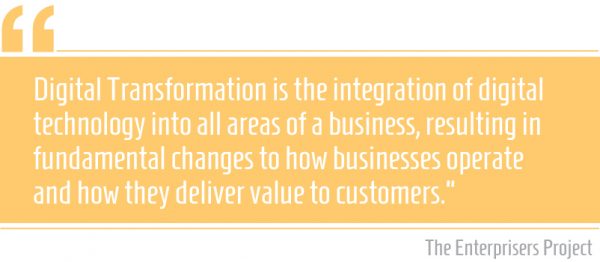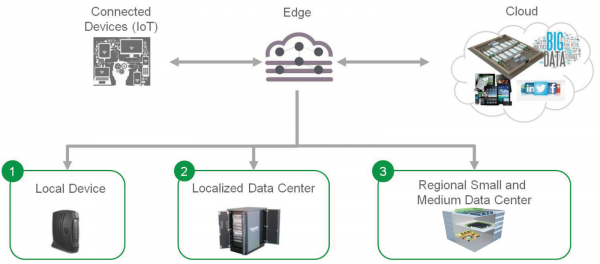This is part 8 in a series exploring design thinking in strategy development. If you are just joining, I encourage you to start at the beginning and read part 1 here.
What Is Digital Transformation?

We couldn’t conclude this series without discussing Digital Transformation (DX) and the impact it will have on your organization. The quote above provides a good explanation as to what DX is: a merging of technology into ALL aspects of your business.
What exactly does this mean? It’s a lot to unpack. Organizations that undergo DX come out vastly different on the other side. It fundamentally changes how your organization operates on a day-to-day basis.
DX as a Form of Disruption
Think of DX as a form of disruption. At the beginning of this series, I talked about creating a culture of design that accepts new approaches to solving old problems. That means looking at the way you have been doing business and embracing new processes instead. There are a number of reasons why a business may undergo DX. But the most likely is this: it’s a survival issue.
If someone asked you whether or not your organization is viewed as a disruptor in your industry, how would you respond? According to Forrester’s “Assess Your Digital Disruption Readiness Now” report, a third of businesses don’t feel they are able to disrupt themselves in the face of digital change. Alarmingly, only half of businesses surveyed believed they had the business practices and policies in place to adapt to digital disruption.
Odds are, there is a startup somewhere figuring out how to disrupt you. Just ask Blockbuster, Kodak or Blackberry if you want proof. All have been disrupted—they never saw it coming. Blockbuster actually had an opportunity to buy Netflix, but the company wasn’t in touch with how their consumers wanted to ingest media. Kodak once said that digital photography would never replace film. Blackberry used to be a household name and THE enterprise solution for mobile devices. If you still don’t think that your business will be disrupted, you won’t have a business in 5-10 years.
How to Accelerate Digital Transformation
Step 1: Culture
First and foremost, you need to adjust your organization’s culture. This will be the most time-consuming step. It will require accessible leadership, shifts to collaborative office layouts and changes in KPIs to measure performance. In short, you must develop a culture of design.
- Change your dress code to align what makes your employees feel comfortable.
- Begin to evaluate people based on innovation and customer engagement.
- Encourage out-of-the-box ideas and reward ideas that work.
- View and treat failures as learning opportunities.
- Build a culture of constant change.
Step 2: Technology
Implementing new technology solutions is easy. Finding the right technology to use is not. The right technology should enhance your relationship with the customer. Remember, your customers are the key to your success, and you need to understand their expectations. This is where a constant practice of empathy comes in—from all levels of your organization.
- Discover what products and services your customers use.
- Find out how your products and services stack up to the competition.
- Leverage technology to offer better user experiences.
Customers settle for subpar experiences when there aren’t any other options. One startup can disrupt everything. Just look at Uber or Lyft. They didn’t invent the rideshare concept, but they made it a better experience. Can you afford to lose an entire customer base to another product or service?
Step 3: Operational Processes
Automation. Digitization. These are the tools that come to mind when we think of DX. Automation allows your organization to focus more on strategy, and digitization means that you are longer limited by your physical location. The result is unprecedented knowledge sharing—your employees can communicate with anyone from anywhere.
- Shift to automated, digital processes.
- Get deeper insights through IoT and connected devices for more informed decision making.
The Role of CIO in DX
In the past, CIOs were concerned with controlling costs, processes and support. Rarely were they invited to strategic meetings. Now? Those days are over. To transform your organization, you need to transform the role of the CIO. They must be a champion for DX and building a culture of design. The CIO of the transformed organization will use their technical background less and focus on digital strategy more. They will work to understand customers and how the digital world plays into their everyday lives. The CIO should work collaboratively, allowing business owners to understand the role of technology in their products and services.
7 DX Trends
DX is a necessity, and companies unable or unwilling to prepare for disruption will fall. And shifting company culture is only going to get harder as time goes on. As the pace of change continues with advances in technology, being an organization that moves fast will be even more important. To be a champion of DX, you must be aware of the seven trends that are currently disrupting the industry. Ask yourself where your organization falls within these areas:
1. The Internet of Things (IoT): There are a lot of devices on the web, and this is less about the devices and more about what you do with the information the devices capture. Gartner estimates more than 8.4 billion “Things” are on the internet today, up more than 30% from just one year ago.
- Analytics: Data is the currency of the future and IoT delivers data aplenty. In fact, Cisco states that the IoT currently generates 403 zettabytes of data per year. What’s a zettabyte? One trillion gigabytes. This trend will only grow as more and more products are being connected to the internet. If you are drowning in data now, IoT will make things worse. However, with that data also comes unprecedented insight into manufacturing processes, customers and sales.
Edge Computing: With so much data, it will become impractical to send it all up to the cloud. Edge computing allows organizations to analyze data in real-time. The “edge” in edge computing comes from where the data is processed—on the edge of the network. It analyzes data closer to its source, reducing the bandwidth needed and skipping the step of remote processing. Here’s a diagram to help you visualize how it works:

4. 5G: With all of this data circling overhead, providers will need to transfer that information faster. That is where 5G comes in. There will still be development within the LTE space as we see gigabit LTE come on board. 5G is the next step in that evolution.
- Blockchain: While you may be familiar with blockchain in terms of Bitcoin, it has many other practical uses. Blockchain is a public, electronic ledger that can be shared among disparate users. It creates an unchangeable record of transactions, each time-stamped and linked to the previous one. Each digital record or transaction is called a block, and each block is linked to a participant. Either an open or controlled set of users can participate in the electronic ledger.
6. Artificial Intelligence (AI): AI is already mainstream and odds are, you are using it daily in products such as Siri, Alexa and customer service chatbots. AI on the business side will continue to surprise as organizations use it to connect with their customers and develop deeper insights. AI will continue to create faster, cheaper automation.
- Virtual Reality (VR) to Augmented Reality (AR): While the world has been excited for VR, it will lose significant ground to AR. This technology has been advancing exponentially, and we have seen it used in almost every industry. AR is already being used in manufacturing to help line workers assemble products or troubleshoot issues.
The Next Step: It’s Up to You
In this series, we have covered design thinking as a process, how it is used in developing strategy, how to develop a culture of design and digital transformation. My hope is that you now have enough information to make a case for change, to prepare your organization to be disrupted, and for YOU to be the disruptor. Determine what works best for you and your organization. And if you have any questions or would like to learn more, start a conversation with one of our experts.

